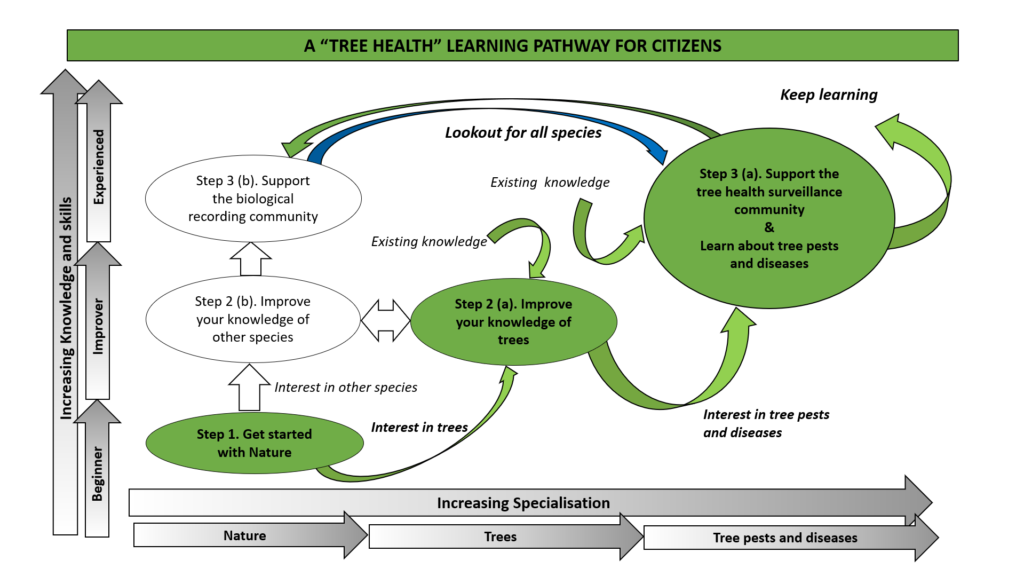
| Task | Resources | Details/Links |
| Learn about nature, plants, animals and fungi | BBC Springwatch | Ideas, information and resources to help wildlife |
| | Field Studies Council | Simple easy-to-use identification guides for a wide range of plant, animal and fungal species |
| Animal and Plant Health Agency | Izzy the inspector, a fun activity book for children | |
| Start looking at nature in your local area | UK Centre for Ecology and Hydrology | Top tips to discover wildlife in your area |
| Wildlife Trusts | Visit a local nature reserve to explore | |
| Podcasts (include trees and many other aspects of nature) | Woodland Walks Trees a Crowd Knepp Wildland Podcast |
AFTER STEP 1, you should:
| Task | Resources | Details/Links |
| Learn to identify different tree species | Woodland Trust | British Tree Identification App |
| | Field Studies Council | The FSC Tree name trail features 34 of the commonest broadleaved and conifer trees found in Great Britain and Ireland |
| Field Studies Council | Tree identification courses | |
| Podcasts | Completely Arbortrary | |
| Visit and get involved with local woodlands | Woodland Trust | Find a wood to explore |
| Try a general tree Citizen Science activity | Treezilla | A Citizen Science project to map, measure and monitor trees |
| Woodland Trust Ancient Tree Inventory | Help find ancient trees across the country Ancient Tree Inventory |
AFTER STEP 2(a), you should:
| Task | Resources | Details/Links |
| Learn to identify different plant and animal species | Field Studies Council | Simple easy-to-use identification guides for a wide range of plant, animal and fungal species |
| | iNaturalist | App to identify species from photograph (they have communities of experts to help you too) |
| iSpot | App to identify species from photograph (they have communities of experts to help you too) | |
| Visit and get involved with local nature reserves or parks | Wildlife Trusts | Find a local nature reserve to explore |
| Parks and Gardens | Find a local park | |
| Try a general tree Citizen Science activity | Woodland Trust Nature’s Calendar | Track the effects of weather and climate change on wildlife near you |
AFTER STEP 2(b), you should:
AFTER STEP 3(a), you should:
| Task | Resources | Details/Links |
| Get involved with a specialist ecological/ biological recording society(ies) | Biological Records Centre | A national focus for terrestrial and freshwater species recording schemes and societies |
| | British Ecological Society | A learned society – the oldest in the world for the advancement of ecology |
| National Biodiversity Network (NBN) and NBN Atlases | A national network and online platform to share biological data NBN Atlas NBN Atlas Scotland NBN Atlas Wales NBN Atlas Northern Ireland NBN Atlas Isle of Man | |
| Help out by looking for tree pests and diseases | TreeAlert | The website for reporting signs of dangerous tree pests and diseases in Great Britain |
| TreeCheck | A website for reporting signs of dangerous tree pests and diseases in Northern Ireland (and Ireland) |
AFTER STEP 3b, you should:
Finally, the table below lists a few resources to help you enjoy the countryside and woodlands without inadvertently spreading pests and diseases yourselves.
| Organisation | Resource | Details/Links |
| European Plant Protection Organisation (EPPO) | “Don’t Risk it” | Downloadable posters for tourists and travellers |
| Forestry Commission and Animal and Plant Health Agency | How biosecurity can prevent the introduction and spread of tree pests and diseases | Comprehensive information, guidance and further links |
| Scottish Forestry | “Keep it clean – don’t give tree pest and diseases an easy ride” | Biosecurity advice to help to protect our trees |